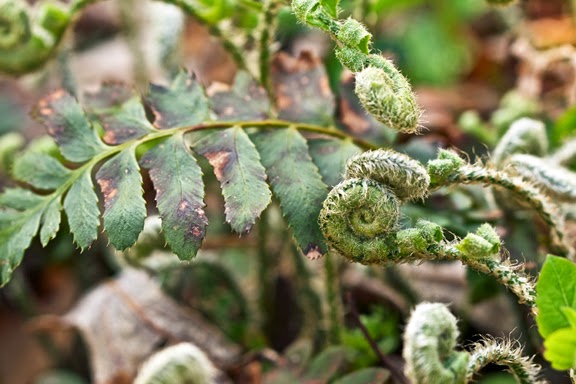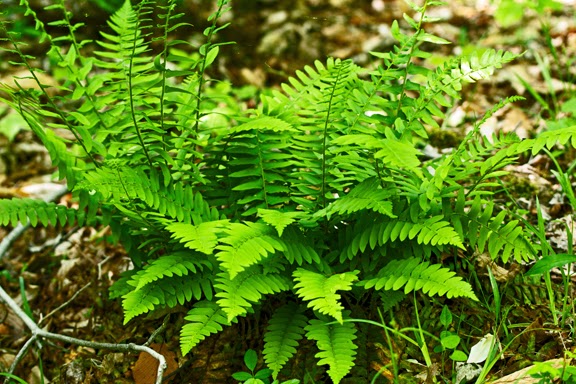Ferns and Such things
Green is the color for today.
Everything is growing like mad and the woods are filled with green - everything is GREEN! HURRAY!!! What a lovely change from snow. We went out to order a compost delivery and there are hundreds of shades of green, mixed with other colors, filling the landscape, covering the hills, and bordering the streams and creeks.
I'm not home much this week and time is short, so you will have a blog post filled with fern pictures. Beautiful, graceful, green ferns and a couple of non-related things as well. I was hoping to research the names for you, but no time. Enjoy the pictures and I'll try to get names of most of these for future posts. All these are local and grow in semi-shaded locations with reliably damp earth (our woods, mainly).
There are something like 65 kinds of ferns in Pennsylvania, some quite rare. They propagate themselves through the spread of their spores, a sort of seed but not. Most are moderate in size, but the Cinnamon/Christmas ferns can get very tall. Here is an online writeup about ferns that gives good, general information. http://en.wikipedia.org/wiki/Fern
When the ground first begins to warm in March and April, ferns begin their growing season. Many open from a curled up state called a fiddlehead. Fiddleheads of certain ferns are eaten (gently sauteed in butter) and considered delicious by many. My brother and his family grow ferns and eat the fiddleheads in early spring, although they say, eh - rather tasteless. I guess, like all things in life, it's a matter of personal taste:>). Some ferns begin life quite pale in color and deepen their green as they mature. Some have different colors for new growth (there is a reddish brown example below) that is rapidly overtaken by green as food is made and stored. Plants make their food through photosynthesis. The green chlorophyll in a plant takes sunlight and converts it to a sugar compound for food for the plant. To do this, plants absorb sunlight in the red and blue color ranges; they can't use light in the green range for their food-making so green is not absorbed into the plant. The green we see is actually the reflected light a plant cannot absorb. The reason there are different shades of green is because each plant uses differing amounts of reds and blues in their food factories making the reflected light slightly different.
If you want to read up on photosynthesis you can check these out.
http://www.biology4kids.com/files/plants_photosynthesis.html
http://biology.clc.uc.edu/courses/bio104/photosyn.htm
http://www.kidsdiscover.com/infographics/infographic-photosynthesis-for-kid/
One of the byproducts of photosynthesis is oxygen. Plants return oxygen to the air as the food-making process goes on.
As you browse through these pictures, take notice of how different the many kinds of fronds (leaves) look. They are different shapes and sizes.

 |
| These tiny "grapes" are where the spores are made. |
As the spring progresses into summer, ferns come into their glory - lush, green foliage fills the woods and ditch edges. Many gardeners love ferns and plant them where the shade makes it difficult for flowers. Here are more images of beautiful ferns.
 |
| Here you can see the old leaves from last year (lower) and this Spring's new growth (upper). |
Some ferns are considered evergreen while others are deciduous (loosing their leaves in autumn like many trees). Those evergreen types of ferns usually have a tougher, leathery frond (leaf) than those that die back and sleep until springtime nudges them awake once again.
There are different ways for ferns to make their spores, too. Some are formed in capsules and others are nurtured on the underside of the fronds Here is a small sampling -
The Scouring Rush, or Horsetails, can be found in the same type of locations as ferns, but are especially happy where there is very wet soil. They are written up here in more detail.
http://en.wikipedia.org/wiki/Equisetum
 |
| Horsetails as they first appear in springtime. |
Thanks for your patience:>) I'm writing this on Tuesday night at 11:30 PM and scheduling it to publish on Friday. I'll be away but wanted to be certain a blog post happens. Forgive any typos (I am the typo QUEEN!) or silly English. I have a love/hate relationship with spell check.
Have a great weekend, and as always I thank you for making time to come by and visit the blog.
PS: Here's a little something extra - our bird seed, bird suet thief:>)
























































No comments:
Post a Comment
Please feel free to leave a comment and let me know what you think about this blog.